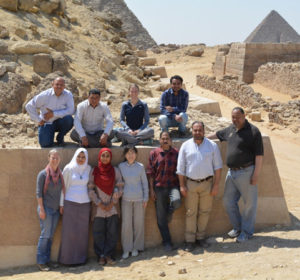 The 2017 Giza season consisted of an intense six weeks of study and ‘stock-taking’ in our Giza Lab.
The 2017 Giza season consisted of an intense six weeks of study and ‘stock-taking’ in our Giza Lab.
- The ceramics team (Mahmoud el-Shafei and Aisha Mohammed) studied materials from relatively recent excavations – the 2012 work in Khentakawes East area, and 2015 work in AA South. Over four weeks they were almost able to catch-up on these analyses, and put the finishing touches on their reports for those areas.
- Manami Yahata, who excavated in the Soccer Field West House Unit 1 area several years ago, has always been interested in the large quantities of roofing materials from this house, and because we had a study season, she was able to conduct analyses of these remains, recording the various different types of impressions from logs, branches, matting etc found in anonymous-looking lumps of sandy-mud!
- Ali Witsell, one of our sealings specialists, joined us for a week to make an assessment of what will be needed in the future to complete the analyses of our sealings material.
- Samar Mahmoud, a field-school student in 2015, is studying lithics as part of her Masters program, and was able to join us for a few days a week. She looked at materials from much older excavations, in the Main Street East area (2006-2007), in which large quantities of the debris of stone-tool production were discovered.
- We continued our mission to train young Egyptian archaeologists this season; Essam Ahmed, a student-botanist from the National Museum of Egyptian Civilisation (NMEC) was assigned to us as a trainee in Archaeobotany.
- We were also joined by Sarah Hitchens, a PhD student at the University of Liverpool who is making a study of our textile-production tools.
- Dr. Claire Malleson oversaw the BIG job of the season, which was to undertake a huge inventory and stock-take of all the materials stored in our lab. After 29 years of excavations we have vast quantities of ceramics, stone tools, artefacts, faunal remains, archaeobotanical remains, charcoal, sealings, shell, plaster fragments, human remains, and industrial ‘waste’ materials stored in our workroom/Lab on the Giza Plateau. In order to move forward with our research on the lives of the people living in the Heit el-Ghurab and Khentkawes towns it has become very important to properly assess just what we have, what needs to be studied and what has been studied in the past. Over 6 weeks Sarah and Claire, working with our two long-standing Egyptian lab assistants, listed over 14,000 bags of lithics, 5000 bags of faunal remains, 3000 botanical samples, 3000 bags of charcoal, 70 boxes of painted plaster, 200 boxes of shell, remains from 400 human burials, 100 bags of industrial waste material samples, and 100 boxes of roofing material impressions. In most cases the materials we inventoried have never been studied (for example, over 3000 botanical samples have been studied in the past, and we recorded 3000 which are awaiting study).
This season has served as a very useful reminder of the crucial importance of study seasons in archaeology. It can take just 5 minutes to dig and 30 minutes to record a deposit. But it can take many weeks and many different people to analyze the material from that deposit. Without study seasons, it is impossible to keep up!
